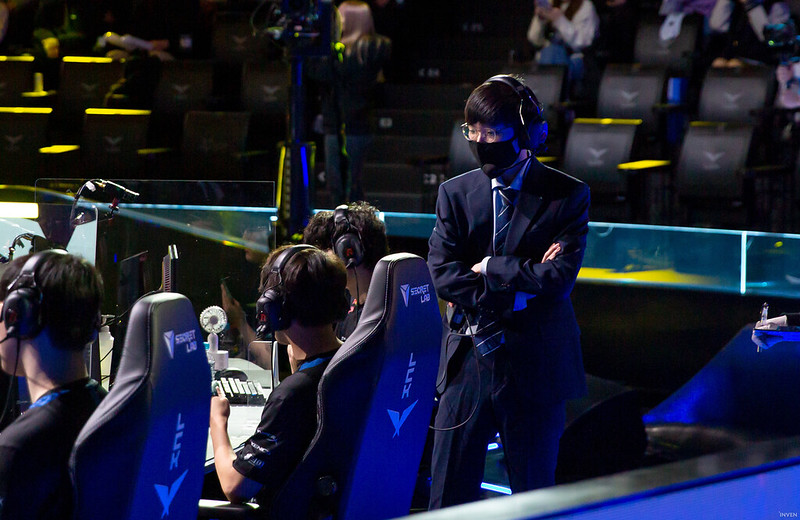
When it comes to training their players and teams, the standard for esports organizations is to arrange scrims with other teams to train. These practice sessions are then followed by feedback sessions from the coaching staff, whose job is to align and harmonize the individual players' performance and playstyle with the team's general direction. That's about it — the everyday fan, at least, wouldn't know much more.
In traditional sports, teams' training sessions look a bit different where drills are a core part of practice. In basketball, players will train to dribble, pass, and shoot. In baseball, they'll train pitching, hitting, and fielding. Team practice games would follow these individual drills, where the whole team can practice team strategy and synergy.
Are League of Legends orgs similar in that way? Do pro players go through drills like in traditional sports, or is it just scrimming all day long?
Do esports players consistently work on fundamentals?

Fundamentals are one of the most important elements in any sport, even to those who are already at the top. These basic skills keep the player in shape and able to react adequately in diverse situations, so the best athletes still practice them religiously.
That's not exactly the case in a game like League of Legends. In 2018, Liyu “Cody Sun” Sun told Intel that top tier players don't really do drills, because they already have to be good at the basic mechanics like last hitting minions or Flashing. Therefore, their main focus is on scrims and playing solo queue.
Cody Sun's quote, however, is from four years ago. To understand whether practice methods have changed since, we approached active and former LCK coaches to inquire how the historically best region in the world stays dominant.
Do LoL esports pro organizations work on fundamental drills?
Coach A: We used to have players run drills on fundamentals they needed to improve. Like in traditional sports, esports players also acquire patterns and habits, so we guided the players to incorporate them through drills. The latter were mostly about last-hitting, moving, hitting skillshots, pathing, etc.
There was even a player whose drill was to collect 100 CS with Vladimir as soon as he got up and before he went to sleep. The result was pretty good. We also recorded all the players’ personal screens and tried to analyze them to improve even the smallest basic skills they had.
Coach B: We mostly leave it to the players, using the practice mode. We often make junglers use the practice mode to optimize their pathing. Some players practice skillshots while they warm up, playing Ezreal or Lee Sin before they start scrims.
I don’t know about other teams, but if there are players that drastically underperform in scrims, I make them play at least one solo queue game, or even a game of ARAM before going back to scrims.
Coach C: There aren’t any systematic "drills" that we do as a team. We just leave it to the players, so that they could play solo queue and do what they need to do — we consider this fundamental training. For bot duos, we have them practice laning, so this could be called a "drill". They play against other laners, other team bot duos, or academy duos. They select a specific comp and practice laning repeatedly.
What about strategy training?

If fundamentals are important for the players to improve their individual performance, strategy training is necessary to lead the team to victory. It’s a process of thinking about how someone will move, or what to focus on while playing the game. When something familiar happens in-game, prepared and practiced responses can be the aid to winning the game. Strategy training is how players imprint these situations on their skillset so they can execute them to a T when the time comes.
In esports, and especially in League of Legends which features different drafts every time, it is difficult to create a specific situation for the purpose of strategy training. Nevertheless, practicing these situations as much as one team can is still necessary.
Do League of Legends organizations have strategy training sessions?
Coach A: Depending on the meta, we consistently practice setting top and bottom lane priorities to optimize the laning phase. Besides that, we find the best champions for each lane, the optimal ways to teamfight and position according to the composition, figure out how to defend vision, how to deal with level 1 fights and invades, how to seal a lead or turn around a deficit, etc.
We also practice how to speed up the game when we have the initiative, and ways to delay the game when we have a late-game comp. As we have academy players, it was easy to practice certain tactics or situations repeatedly, and we also tried having mock drafts to replicate those situations.
Coach B: Since most of the practice is having scrims with other teams, it’s hard to practice specific situations consistently. There are still ways, though, such as asking the opponent team in advance to create the situation. After we play through the scrim, we do it again, perhaps with the sides reversed, so that it benefits both teams.
Nowadays, all teams have Challengers/academy teams, so they can practice those situations with them, but the power gap between LCK and the lower teams is not always meaningful. When they practice bot duo matchups, LCK bot duos often win unfavorable matchups against Challengers bot duos.
Coach C: When we pick a draft with a specific concept, like Caitlyn-Lux or Ezreal-Karma, we do some practice that can be considered a drill. We also practice macro for when we pick sidelane macro champions. Working on positioning in teamfights or getting objectives is also something we focus on, so that could be considered strategy training. We don’t actually create these situations — when they happen in scrims, we work on them and see how much the players adapt from the feedback.
When we practice lane matchups, we naturally learn when a certain champion gains priority, so we build the jungle paths around that. We divide the map in half and decide if we’ll pressure to make dives or do something different.

From our conversations with the LCK coaches, it seems that League of Legends is a bit different than traditional sports and is more akin to games of the mind like chess or Go. The players in these games also mostly train through actual matchups, simulations for certain situations, and feedback. LoL orgs seem to follow that model: while some have their own training sessions and drills, the majority of practice comes from scrims, while fundamental training comes from solo queue.
However, as the esports industry matures, it's likely that these training methods change with the times too. Positions like role-specific coaches and sports psychologists are already common in the field compared to several years ago, and there's no reason to believe that pro gamers' practice will remain the same as it is today.
Sort by:
Comments :0








